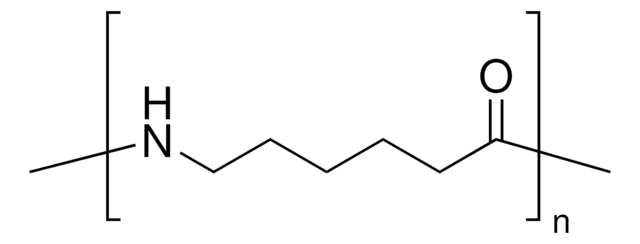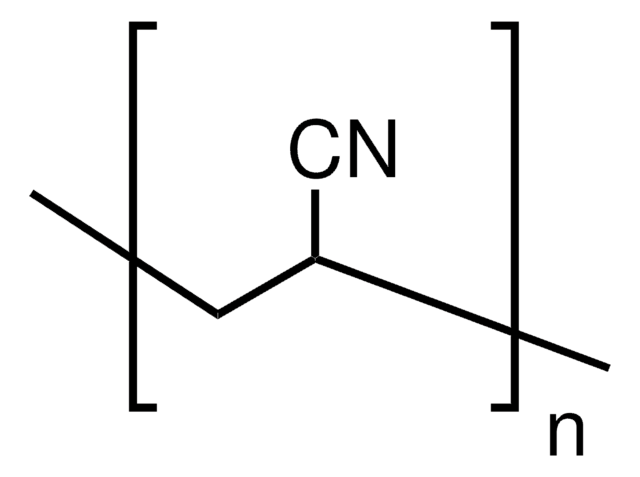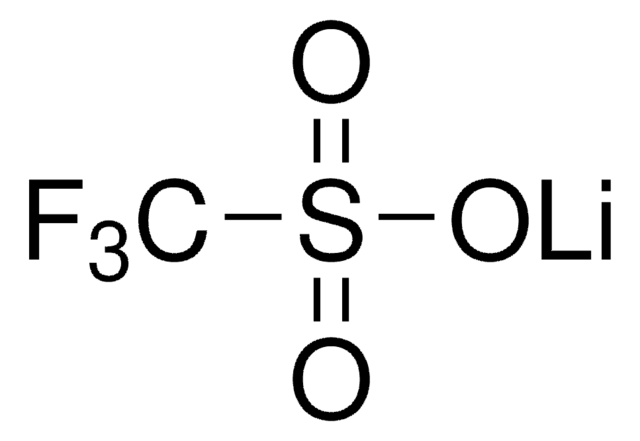182028
Poly(ethylene oxide)
average MV 600,000 (nominal), powder, hydroxyl, BHT as inhibitor
Sinónimos:
Polyethylene oxide, PEO
About This Item
Productos recomendados
product name
Poly(ethylene oxide), average Mv 600,000 (nominal), powder
formulario
powder
Nivel de calidad
mol peso
average Mv 600,000 (nominal)
contiene
200-500 ppm BHT as inhibitor
viscosidad
4,500-8,800 cP, 5 % in H2O(25 °C, Brookfield)(lit.)
temperatura de transición
Tm 65 °C
Ω-final
hydroxyl
α-final
hydroxyl
aplicaciones
battery manufacturing
cadena SMILES
[H]OCCO
InChI
1S/C2H6O2/c3-1-2-4/h3-4H,1-2H2
Clave InChI
LYCAIKOWRPUZTN-UHFFFAOYSA-N
¿Está buscando productos similares? Visita Guía de comparación de productos
Descripción general
Aplicación
- Bioabsorbable and injectable hydrogels for sustained drug release.
- PEO/graphene oxide composite electrolyte membrane for fuel cells.
- Poly(ethylene oxide)-b-poly(ε-caprolactone) (PEO-b-PCL) diblock copolymer. Losartan potassium encapsulated (PEO-b-PCL) copolymer can be used as a drug carrier.
Código de clase de almacenamiento
11 - Combustible Solids
Clase de riesgo para el agua (WGK)
WGK 1
Punto de inflamabilidad (°F)
Not applicable
Punto de inflamabilidad (°C)
Not applicable
Equipo de protección personal
Eyeshields, Gloves, type N95 (US)
Elija entre una de las versiones más recientes:
¿Ya tiene este producto?
Encuentre la documentación para los productos que ha comprado recientemente en la Biblioteca de documentos.
Los clientes también vieron
Artículos
In this article, we discuss issues critical to successful application of the electrospinning technique, including control of individual nanofibers to form secondary structures and assembly of nanofibers into 3D architectures.
Progress in biotechnology fields such as tissue engineering and drug delivery is accompanied by an increasing demand for diverse functional biomaterials. One class of biomaterials that has been the subject of intense research interest is hydrogels, because they closely mimic the natural environment of cells, both chemically and physically and therefore can be used as support to grow cells. This article specifically discusses poly(ethylene glycol) (PEG) hydrogels, which are good for biological applications because they do not generally elicit an immune response. PEGs offer a readily available, easy to modify polymer for widespread use in hydrogel fabrication, including 2D and 3D scaffold for tissue culture. The degradable linkages also enable a variety of applications for release of therapeutic agents.
Devising biomaterial scaffolds that are capable of recapitulating critical aspects of the complex extracellular nature of living tissues in a threedimensional (3D) fashion is a challenging requirement in the field of tissue engineering and regenerative medicine.
Nuestro equipo de científicos tiene experiencia en todas las áreas de investigación: Ciencias de la vida, Ciencia de los materiales, Síntesis química, Cromatografía, Analítica y muchas otras.
Póngase en contacto con el Servicio técnico








